The exemplary international mobilization that jumped to aid Haiti after the January 12 earthquake, and the January 20 aftershock, is now being followed by a cohort of studies on the risks associated with the fault lines on which the country is resting. The island of Hispaniola, hosting Haiti and the Dominican Republic, lies exactly on top the Enriquillo-Plantain Garden fault system, which separates the Gonave microplate from the Caribbean tectonic plate. With help from new satellite data, and Synthetic Aperture Radar (SAR) observations, researchers can now piece together an image of the plumbing below the entire region.
Furthermore, based on these datasets, geologists can now attempt to gauge the risk associated with the still-unstable fault system. What puzzled the scientists first off was the fact that the 7.0-magnitude earthquake did not rupture all the way to the surface, They say that this is very odd for such a powerful tremor. Additionally, satellite data revealed that the eastern part of the fault did not rupture during this earthquake, which may bring about a hazard in the future. “We're still waiting for the other shoe to drop,” University of Miami Rosenstiel School of Marine & Atmospheric Science (RSMAS) Professor of Geology and Geophysics Tim Dixon explains.
“Given the plate tectonic setting scientists expected mainly sideways motion, yet there was a large amount of vertical motion during the earthquake. This explains how such a relatively small rupture was able to generate such a large earthquake,” RSMAS Professor of Geology and Geophysics Falk Amelung says. The new data was collected from the ALOS satellite, which is operated by the Japanese space agency, JAXA. It was made available to researchers via efforts from the European Space Agency and the Group of Earth Observation (GEO).
“There's a reasonable probability of another large quake, similar to the January 12 event, striking Port au Prince within the next 20 to 30 years. I'd like to see them relocate critical infrastructure such as government buildings, schools and hospitals, farther north out of the danger zone,” Dixon adds. On the bright side of things, it would appear that geologists who have argued all along that this specific fault line can trigger tremors have been correct. “This is a relief, because it shows that our current ideas about the tectonics of the area are correct,” Amelung reveals.

 14 DAY TRIAL //
14 DAY TRIAL //